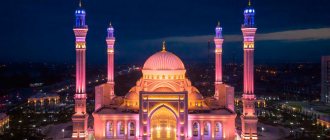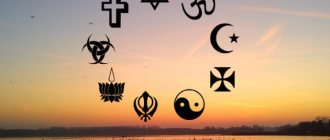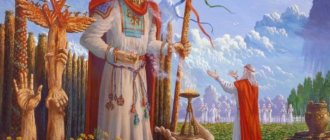↑ National religions
National
or
national-state religions
are religions that have developed within certain states or peoples.
In the modern world, many national religious beliefs coexist.
Signs of national religions
:
- arose during the formation of the early state;
- worship of the gods or the patron god of one’s people;
- the presence of complex ceremonies and rituals;
- the appearance of religious servants (priests, brahmans).
These include:
- Shintoism (Japan);
- Jainism (India);
- Confucianism (China);
- Taoism (China);
- Zoroastrianism (Iran);
- Judaism (Palestine, Israel);
- Hinduism (India) and many others.
Judaism
Judaism began as a contrast to Hellenistic paganism, and the term first appears in historical writings in the 1st century BC.
It was formed among the Jewish people as an ethnic belief, and is one of the oldest monotheistic religions in the world, dating back 3.5 thousand years.
Today, Judaism has about 14.5 million followers of this religion around the world, but the bulk of believers are concentrated in Israel.
↑ World religions
World religions
- These are religions that have gained recognition among the peoples of many countries.
These include Christianity, Buddhism and Islam
.
Main features of world religions
cosmopolitanism (international and supra-ethnic character);
egalitarianism (preaching the equality of all people);
a large number of followers around the world;
propaganda activity (the desire to convert others to one’s faith).
Christianity
unites three large directions:
Orthodoxy
,
Catholicism
and
Protestantism,
which were formed during a series of historical events.
The basis of Christianity is the belief in the Holy Trinity - God the Father, God the Son and God the Holy Spirit. The main source of faith is the life and teachings of Jesus Christ as described in the New Testament of the Bible. Having been persecuted for preaching, he was martyred on the cross, thereby atoning for the sins of people and resurrected, and ascended to heaven, showing for those who believed in him a new life, the path to reunification with God in the Divine Kingdom. Soon the followers of Christ began to build churches. Over time, churches begin to strive for autocephaly
(independence). This process began in the 3rd - 4th centuries. during the crisis of the Roman Empire. Thus, the Constantinople, Alexandria, Antioch, and Jerusalem autocephalies were formed. Soon the Cypriot and then the Georgian Orthodox Church and the Armenian Gregorian separated.
The split of the Christian faith into Orthodoxy and Catholicism occurred in 1054, when the Pope and the Patriarch of Constantinople declared anathema
(subjected to a church curse), due to many disagreements.
Several centuries later in the 16th century. As a result of the Reformation
(the struggle for the reconstruction of the church), another Christian movement was formed in Europe - Protestantism. In Protestantism, the primacy of the church, its wealth, the priesthood, and monastic orders are refuted; only the personal relationship between man and God is recognized. Currently, Protestantism unites many independent movements, churches and sects (Lutheranism, Calvinism, the Anglican Church, Baptists, Adventists, etc.).
Catholicism and Protestantism share with Orthodoxy all the basic tenets of doctrine and worship. The difference in directions is manifested only in the conduct of rituals and external veneration of God.
Directions in Christianity
Buddhism.
The beginning of the most ancient of the world's religions, Buddhism, goes back to the deep past.
The founder of Buddhism is the son of the ruler of the Shakya family, Siddhartha Gautama,
who lived approximately 583-483.
BC e. Having enjoyed all possible material benefits, at the age of 29, dissatisfied with life, he leaves his family and becomes an ascetic. After many years of this lifestyle, he achieves awakening ( bodhi
) and receives a new name - Buddha, which means "enlightened one."
Buddha began to preach a new worldview and a new path for man, which can save him from suffering. Buddha saw salvation in achieving a certain state of harmony, peace and tranquility - nirvana
, which occurs as a result of meditation and self-improvement, and also after one manages to overcome all human desires, passions and fears.
Currently, Buddhism is a collection of movements and directions, quite different from each other.
Islam.
The youngest world religion is Islam (from Arabic “submission to God”) or Islam. Currently, Islam has become widespread outside the Arab world; there are adherents of Islam in almost every country. In some countries, Islam has been approved as the state religion (Egypt, Iran, Iraq, Morocco, Saudi Arabia, etc.).
The founder of Islam is the prophet Muhammad
lived approximately 570-632. At a time when the Arab nomadic tribes were divided by different beliefs, he proclaimed one god, Allah. Despite the fact that initially the prophet’s views did not find wide support among the citizens of Mecca, Muhammad had to move in 622 to the city of Yathrib, which was later renamed Medina (“city of the prophet”). From this event (Arabic “hijra” - “migration”) the Muslim calendar begins. So, 2021 Hijri year 1437-1438.
The main provisions of the doctrine of Islam are set out in the main “holy book” - the Koran
. According to legend, the contents of the Koran were told to Muhammad by Allah himself through revelations through the angel Jebrail, mainly at night through visions.
↑ World religions: table
| Comparison criteria | Buddhism | Christianity | Islam |
| Time and place of origin and spread | Benares, Hindustan Peninsula, 6-5 centuries. BC e. Distribution: Burma, China, Vietnam, Korea, Japan. Religious community - sangha | Palestine, 1st century n. e. Worldwide distribution. Religious organization - church: Orthodoxy, Catholicism, Protestantism | Hijaz, Arab Caliphate, 7th century. n. e. Distribution: Middle East, Central Asia, North Africa, North Caucasus, Transcaucasia. Religious community - ummah |
| Name of the prophet, name of the holy book | Buddha (enlightened one), Tipitaka | Jesus Christ (messiah, anointed one), Bible | Muhammad (Mohammed), Koran |
| Basic ideas of religion | 1. Life is suffering, it is caused by the passions and desires of people; to get rid of suffering, you need to give up desires. 2. The idea of transmigration of souls. 3. You need to strive for nirvana | 1. The idea of monotheism: God is one, appears in three persons: God the Father, God the Son, God the Holy Spirit. 2. The idea of messianism: Christ was sent by God to save people. 3. The idea of the end of the world: the death of the world as a result of Divine intervention | Strict monotheism. “There is one God - Allah - omniscient and omnipotent. He created the world and rules it." Muhammad is his messenger. Allah has prepared his own destiny for everyone; the believer is required to submit to the will of Allah. Everyone is equal before Allah: both the poor and the rich. He does not make national distinctions; he distinguishes three statuses of a person: true believer, protected, pagan. The idea of the end of the world and the onset of Judgment Day |
Confucianism
Some experts do not recognize Confucianism as a religion, believing that it is a philosophical teaching. But the worldview that has developed over many centuries can rightfully be considered a religious movement.
Confucianism is a Western term, because in China this religion is called the “school of learned scribes.” It is quite difficult to identify adherents of this teaching, since many in China simultaneously profess Confucianism and adhere to the tenets of Chinese folk religion.
But today it can be said that there are about 6.7 million adherents of this amazing eastern teaching around the world.
Spread of religions
Spread of religions around the world. Sometimes the percentage of adherents is given as a percentage of the total population.
Baha'ism is a cosmopolitan religious and political movement; spread to the countries of the Middle East, Western Europe, and the USA. The core of the Baha'i faith is based on monotheism and believes in one eternal, transcendent God. Baha'ism preaches the idea of denying national state sovereignty, combining science and religion, etc. Baha'ism got its name from the nickname of its founder, Mirza Hussein Ali Beha'u'llah (literally, the splendor of God). Baha'ism originally emerged in Iraq in the mid-19th century. as a sect among the Babis who fled Iran from the persecution of the Shah's government after the suppression of the Babis uprisings of 1848-1852. The provisions of Beha'u'llah, set out by him in his messages (laukhs) and the "Holy Book" ("Kitabe Akdes"), were supposed to replace the Koran and the "Beyan" of the Bab. Beha'u'llah eliminated its revolutionary democratic elements from Babism and opposed revolutionary methods of combating the Iranian reaction, defending private property and social inequality. The main centers of Baha'ism are in the USA (Illinois) and in Germany (Stuttgart).
Hinduism
In fact, it is a synthesis of many Indian beliefs, which is based on the belief in a universal god who creates, supports, and at the same time destroys the Universe.
Literally, the term means “eternal religion,” and Hinduism’s roots go back to the distant past, although the exact date of its birth is quite difficult to determine.
Despite the contradictions in views, there are about 1 billion followers of this religion in the world, mainly living in the countries of the Southeast region.
Buddhism - Main religious movements
Buddhism is one of the three world religions along with Christianity and Islam. Buddhism originated in ancient India in the 6th-5th centuries. BC. and in the course of its development it was divided into a number of religious and philosophical schools. The founder of Buddhism is considered to be the Indian prince Siddhartha Gautama, who later received the name Buddha, that is, the awakened one, the enlightened one. A distinctive feature of Buddhist teaching is its practical orientation. From the very beginning, Buddhism opposed not only the special significance of external forms of religious life, in particular ritualism, but also against the abstract speculation characteristic of the concepts of Brahmanism, and put forward the central problem of the existence of the individual. The main content of Buddhist books is the practical doctrine of “salvation” or “liberation.” It is set out in the doctrine of the “four noble truths”: there is suffering, the cause of suffering, the state of liberation from suffering, the path leading to liberation from suffering; in short, there is suffering and liberation from suffering. On the one hand, suffering and liberation appear as an exclusively subjective state, on the other hand (especially in the systems of developed schools of Buddhism) - as being is suffering, Buddhism defines suffering, first of all, as a certain “reality” that also has an objective (cosmic) basis.
- Hinayana , along with Mahayana, is one of the two main directions of Buddhism. Originated at the beginning of our era. Soon after the advent of Buddhism, the concept of Hinayana was introduced by Mahayana adherents in the early 1st millennium AD. Hinayana includes a number of schools: Theravada, Sarvastivada (Vaibhashika), Sautrantika, etc., although currently Hinayana supporters tend to identify it with the teachings of Theravada (“school of the elders”). In the course of its development and spread, Hinayana established itself in the southern countries (Ceylon, Laos, Thailand, etc.), receiving the name of southern Buddhism. The preaching of personal improvement to achieve “liberation” (nirvana), characteristic of all Buddhism, took in the Hinayana the form of proclaiming the moral and intellectual development of the individual, completely independent of any forces external to man (and above all divine). At the same time, Hinayana is characterized by relatively strict and at the same time negative moral principles. The ideal of the Hinayana is the arhat, a person who unswervingly strives primarily for personal improvement and cares little about the improvement of others. In philosophical terms, this is associated with the non-recognition of the soul and God as independent entities and the affirmation as the only existing individual psychophysical elements - dharmas, certain units of a person’s life activity in inextricable connection with the outside world. Dharmas combine the subjective and objective, material and spiritual and are in continuous movement. Buddha in the Hinayana is a historical figure, distinguished from others by incomparably greater perfection, but not possessing any divine power. He acts as the highest ideal of a human being, a model for others, because potentially any person can become a Buddha.
- Mahayana is the self-name of the largest, along with Hinayana, variety of Buddhism. The highest religious ideal in the Mahayana is considered to be the bodhisattva - the universal, but embodied in the individual, cosmic principle of connectedness through mutual compassion and mutual assistance of all beings striving for liberation from the shackles of worldly existence. Unlike the arhat - the ideal Hinayana saint, who achieved personal liberation by strict adherence to canonical and ritual prescriptions, the bodhisattva acts as a model for others: he himself is not liberated until every single living being striving for liberation is able to take advantage of his example and will not achieve nirvana. More specifically, the concept of a bodhisattva is associated with the accumulation by a person of a certain set of extreme qualities (the so-called paramitas): super-compassion, super-morality, super-patience, super-energy, super-concentration and super-knowledge. The central place in the Mahayana cult is occupied by the symbolism of the “three bodies of the Buddha”: the “body of Law” (“Dharmakaya”) - the image of the universal spiritual existence of the Buddha; “body of Pleasure” (“Sambhogakaya”) - the ideal image of the Buddha, sent down to students in a yogic trance; “the body of the Phantom” (“Nirmanakaya”) - the material human appearance of the Buddha as a subject of exemplary religious behavior. Mahayana religious symbolism is constructed in the form of a complex pantheon of deities who embody personalized values of achieving ultimate liberation. The most important of them: Buddha-Amitabha, or the spirit of Buddhism embodied in the world; Buddha-Avalokitesvara, or compassion directed towards the world; Buddha-Maitreya, or the hope of the world.
Shenism
This is what the Chinese call their Chinese folk religion, which was formed on the basis of a synthesis of various eastern religious movements, and finally took shape in the 17th century.
In the twentieth century, there were several attempts to fight religion, communities and sects of believers were closed, but, despite all the prohibitions, today there are about 450 million supporters of Shenism in China. But we note that in China religion is officially banned.
These religious ideas are based on faith in the forces of nature, the souls of ancestors, faith in reward for actions and faith in heaven as a source of meaning.
☦️
Christianity - Main religious movements
Christianity is a world religion that unites about 2 billion adherents. The essence of Christianity is the doctrine of the God-man Jesus Christ (the Son of God), who descended from heaven to earth and accepted suffering and death to atone for people from original sin. Christianity arose in the 1st century AD. in the Middle Eastern provinces of the Roman Empire. The first, Jerusalem Christian community consisted of disciples gathered around Jesus. By the 4th century, Christianity had become the state religion of the Roman Empire.
- Catholicism or Catholicism is the largest branch of Christianity in terms of the number of parishioners (more than 1 billion adherents), formed in the 1st millennium on the territory of the Western Roman Empire. The final break with Eastern Orthodoxy occurred in 1054. The Universal Catholic Church is divided into Latin Rite Catholicism and Eastern Rite Catholicism. The head of the Catholic Church is the Pope, who heads the Vatican City State in Rome. Old Catholics broke away from the Catholic Church due to rejection of the decisions of the First Vatican Council. In addition, there are a large number of fringe groups that call themselves Catholics, but are not recognized as such by the Vatican. The Catholic Church is the largest (by number of believers) branch of Christianity. As of 2004, there were 1.086 billion Catholics in the world. Their number is constantly increasing due to the growing number of believers in Asia, America and Africa, while in Europe the number of Catholics is gradually decreasing. Catholicism is practiced in almost all countries of the world. It is the main religion in many European countries (France, Italy, Spain, Portugal, Austria, Belgium, Lithuania, Poland, Czech Republic, Hungary, Slovakia, Slovenia, Croatia, Ireland and Malta). In only 21 European countries, Catholics make up the majority of the population, in Germany, the Netherlands and Switzerland - half. A quarter of Ukraine also professes Catholicism.
- Mormonism is the general name of a religious subculture that arose as a result of the spread and development of the Church of Jesus Christ of Latter-day Saints, created in the early 19th century by Joseph Smith in the United States. The cornerstone of Mormon theology is the doctrine of “restoration,” which holds that shortly after the death of Christ's first apostles, the true Church disappeared from the face of the earth. It was not until many centuries later, in 1820, that God chose Joseph Smith to restore true doctrine and the true organization of the church through him. After Smith's death, the role of "prophet, seer, and revelator" was succeeded in succession by fourteen more church presidents. The basic tenets of Mormon belief are written in thirteen Articles of Faith. It should be noted that this document does not provide a complete picture of Mormon beliefs, and many characteristic teachings are not included.
- Orthodoxy is a movement in Christianity that took shape in the east of the Roman Empire during the first millennium AD. under the leadership and with the leading role of the department of the Bishop of Constantinople - New Rome, which professes the Nicene-Constantinopolitan Creed and recognizes the decrees of the 7 Ecumenical Councils. The modern Orthodox Church considers the entire history of the Church before the Great Schism as its history. Orthodox dogma, according to its adherents, dates back to apostolic times (1st century). It was formulated by oros (literally - border, doctrinal definitions) of the ecumenical, as well as some local, Councils. The identification of Orthodoxy against the background of emerging heresies began to take shape in the 2nd-3rd centuries AD. Orthodoxy opposed Gnosticism (which offered its own interpretation of the New Testament and often rejected the Old) and Arianism (which denied the deity of Jesus Christ).
- Protestantism (from the Latin protestans - publicly proving) is one of the three, along with Catholicism and Orthodoxy, the main directions of Christianity, which is a collection of numerous and independent Churches and denominations associated by their origin with the Reformation - a broad anti-Catholic movement of the 16th century in Europe. Protestantism is characterized by extreme diversity in external forms and practices from church to church and from denomination to denomination. For this reason, Protestantism as such can only be described in general terms.
Sikhism
Much in this world originated on the banks of the Indus and Ganges, including the religious belief of Sikhism, translated from Punjabi as meaning “student, follower.”
The founder of the belief was Nanak, who lived at the turn of the 15th–16th centuries. The Sikhs also have their own Holy Scripture - the Guru Granth Sahib. Although the teaching originated among Islam and Judaism, adherents of Sikhism do not recognize consistency.
There are about 22 million people in the world who adhere to this eastern religion.
Islam
The most widespread world religion on the globe originated at the beginning of the 7th century, and today there are 1 billion 555 million believers.
Islam also leads in the number of countries in which Muslim adherents live. Today there are 120 states. The main postulate of Muslims is the belief that God is one, and Muhammad is his last prophet to live on Earth.
The holy book of Islam is the Koran, revered by every believer. Also, every Muslim, at least once in his life, must make a hajj to sacred places - Mecca and Medina.
We advise you to look at our article about the largest mosques in the world.
As we see, any inhabitant of the planet has a choice in choosing a religion, although many beliefs are given to a person by birth or ethnicity.
Protestantism
Another direction of Christianity that arose during the Reformation, as a confrontation with the classical Catholic Church. In the 16th century, the main dogmas and postulates of Protestantism emerged, which over time became a separate religion.
And in Protestantism itself there are several directions, but the differences between them are insignificant. In total, about 800 million people in the world adhere to Protestant ideas. Unlike Catholics, Protestants consider themselves freer from the dogmas of the church, although they are religious conservatives.
The religion is widespread both in European countries and in the New World.
✝️
Orthodoxy
Let us consider Christianity, as a major world religion, in its three directions, and begin with the “correct glorification” of God, or as we are more familiar with Orthodoxy. In the West, Orthodoxy is called Orthodox Christianity.
Today there are more than 230 million Orthodox Christians in the world. The term first appears in the Laurentian Chronicle in 1377, and the main postulates of this movement of Christianity were already formed in the 15th–17th centuries.
Orthodoxy is based on the Holy Scriptures and Holy Tradition. Widespread in the Balkans, in Russia, a significant portion of Orthodox Christians live in North America.
We highly recommend taking a look at the largest Orthodox churches in the world.
✝️










